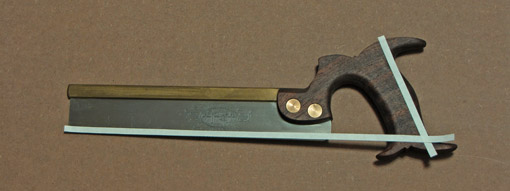
A saw that feels just right in your hand and sails through the wood with ease and control is a wonderful thing. An important factor in this is the angle formed by the handle (tote) of a saw and its tooth line – the “hang” of the saw. Though it gets relatively little attention among the details of teeth-per-inch, plate thickness, set, rake, and so forth, the hang is the foundation of your interface with all the other aspects of the saw.
I propose that it is important enough to be routinely specified by the makers of top quality saws along with the other parameters of the saw. True, it can be estimated by simply looking at the saw, but quantifying it would facilitate its manipulation in designing the saw, just as is done with tpi, for example. Of course, similar to all the other quantifiable elements of a saw, the hang defies formulaic prescription because the many factors all work together to produce the desired sawing mechanics, comfort, and effectiveness.
In the saw above, the hang angle is 66°, defined by the white tape lines. Note that the line on the tote connects the two rounded forward-most points on the surface against which your palm rests. This discussion should not be misconstrued as suggesting that a saw handle can be defined simply by a number. Similar to the weight of a tennis racket, the number gives you some information, a manipulable parameter, but does not negate the importance of balance, shape, and numerous other factors, many subtle.
The rake angle of the teeth, essentially the aggressiveness of the front of the saw tooth meeting the wood, is a particularly important influence on the effectiveness of a given hang angle. Other influences include:
- The height of the work, your bench, and you
- The balance of the saw
- Crosscut vs rip
- Wood hardness
- Tooth sharpness
- Your wrist, preferred grip, stance, and body mechanics
The interaction of all these factors will decide what hang is right for you. The main point is that the hang angle is an important element to be aware of when considering a saw. Of course, this is not something to determine with a computer model in an armchair. Try different saws in different cutting situations and see what works right for you. Nowadays, woodworkers are so fortunate to have tremendous saw makers producing magnificent tools.
Next: I will show an example of a saw hang that I decided I did not like, and what I did about it.


Nice article. As a wheelchair-bound woodworker, I’m always looking for saws with a more obtuse (less acute) hang.
Rob, This is really interesting and I hope you continue to explore these variations in saw architecture, their effects on body mechanics and their interplay.
I recently switched from using a dozuki for dovetailing to using my LN dovetail saw which had been languishing in its box for years. While I could generally use the dozuki for dovetailing comfortably in my workbench front vise. I found I’ve needed to raise my working height about 6″ or 8″ to achieve similar performance.
Interesting points. I never have verbalized the importance of the hang, although it certainly comes into my thought processes – at some level – when I pick up a new saw to try.
The point about the handle being the interface to the saw, and thus a most important factor, is dead on. It seems so obvious once it’s stated that way, and yet I’ve never thought of it that way before.
Especially for beginners, like myself, it would seem that a bad hang could impede good habits from forming during practice.
Shakey,
Great, I hope this helps your work.
Ken,
Yea, ergonomics makes such a big difference in not only the comfort but also the accuracy of woodworking.
Joe,
It really helps to hold the wrist in a natural, stable position.
Thanks for the comments,
Rob